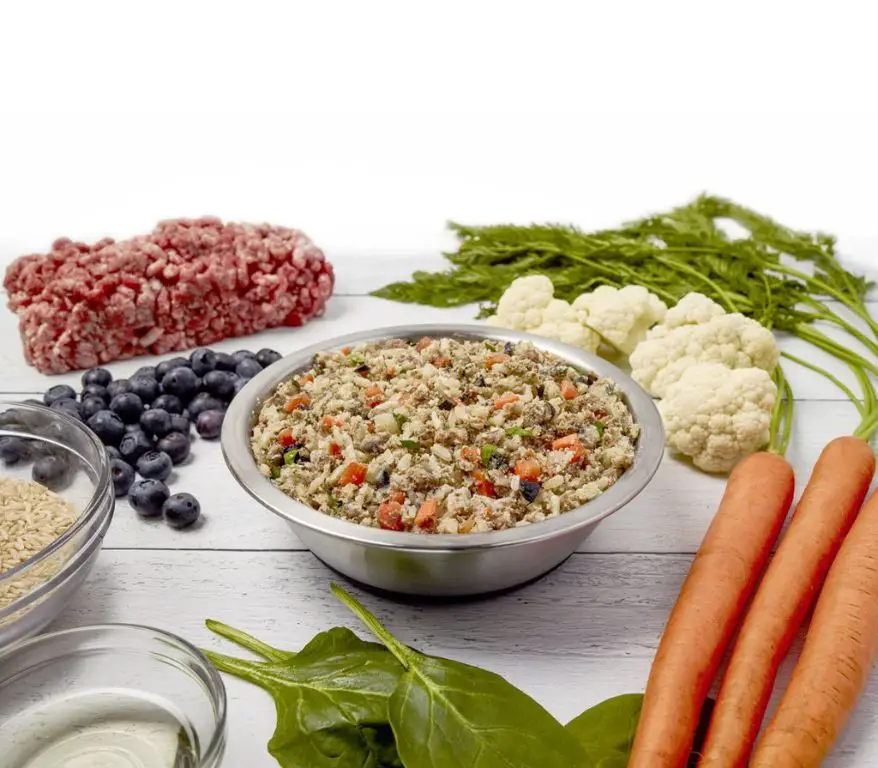Avoid Foods with Artificial Preservatives
Artificial preservatives like BHA, BHT, and ethoxyquin are commonly added to dry dog foods to extend shelf life. However, there are concerning health risks associated with these synthetic preservatives.
BHA and BHT have been linked to cancer, organ system toxicity, and other harmful effects in animal studies. Though the evidence is not conclusive, it’s worrisome enough that many pet owners seek to avoid these controversial additives.
Ethoxyquin has been associated with liver damage, liver cancer, allergic reactions, and reproductive issues based on animal research. It is banned from use in human foods in some countries.
Rather than artificial preservatives, look for natural alternatives like vitamin E, vitamin C, and plant extracts like rosemary. While pricier, brands using wholesome, familiar ingredients give peace of mind.

Checking the ingredient list and avoiding BHA, BHT, ethoxyquin, and other unpronounceable chemicals is smart when choosing a healthy dog food. The fewer synthetic additives, the better.
Say No to Fillers
Many mass-produced dry dog foods use cheap filler ingredients like corn, wheat and soy to reduce production costs. While these carbohydrate-rich plant materials may help hold a kibble together, they provide limited nutritional value for dogs.
Fillers like corn and wheat are difficult for dogs to digest properly compared to quality sources of protein and fat. The starches in these fillers can also lead to rapid spikes in your dog’s blood sugar, potentially contributing to obesity and diabetes.
Fillers are also a common source of food allergies and intolerances in dogs. Reactions to ingredients like corn, wheat and soy can cause symptoms like itchy skin, ear infections, vomiting and diarrhea.
When choosing a dry dog food, avoid fillers high up on the ingredients list. Instead, look for quality sources of meat protein like fresh chicken, beef, fish or eggs. Veggies like sweet potatoes, carrots and spinach also provide more nutritional value than fillers.
Quality dog foods use digestible whole grains like oats, barley and brown rice rather than fillers like corn and wheat. While costing a bit more, these better ingredients provide balanced nutrition to keep your dog healthy.

Don’t Fall for Marketing Tricks
Pet food marketing can be misleading. Terms like “natural” and “premium” are not regulated for pet foods, so companies can use them even when they’re not accurate. Don’t rely on these buzzwords.
Also beware of packaging showing hunks of fresh meat or other ingredients. The images don’t mean that ingredient is the first or main item in the food. Always check the guaranteed analysis, ingredients list, and calorie statement.
The ingredients are listed in order of amount, by weight. Make sure the first ingredient is a named meat like “chicken” or “lamb” rather than a generic term like “meat” or “animal.” The calorie count tells you how much animal protein is included compared to plant material.
Rather than cute packaging and clever slogans, look for pet foods with simple, clear labeling that focuses on the facts of what’s inside. An ethical company has nothing to hide in their ingredients and nutritional analysis.

Avoid Unknown Protein Sources
Many cheap dry dog foods use vague protein sources like “meat meal” or “poultry fat” without specifying exactly which animals they come from. These mystery meat ingredients carry a higher risk of containing low-quality protein remnants, contaminants, and unhealthy additives.
It’s better to look for recognizable, whole food protein sources like chicken, turkey, beef, lamb, or fish. Specific meats like chicken meal, lamb meal, and turkey meal are also acceptable, although less ideal than fresh meats. The protein source should be clearly stated and not disguised under generic terms.
Inspect the ingredient list closely to ensure the main protein source is a quality meat or fish ingredient. Avoid any products that do not transparently disclose the exact type of protein used. High-quality dog foods will proudly display the protein source rather than hiding it.
Steer Clear of Too Many Carbs
Dogs don’t metabolize carbohydrates as efficiently as they do meat and fat. While carbs provide a quick source of energy, excess carbs can lead to obesity, diabetes, and heart disease in dogs. Dry dog foods with too many carbs often contain cheap fillers like corn, wheat, rice, and soy.
When shopping for dry dog food, look for brands with less than 30% of calories from carbs. Acceptable carb sources include digestible whole grains like oatmeal, barley, and brown rice. Avoid fillers like corn, wheat, white rice, and soy which are linked to allergies. A dog’s ancestral diet was low in carbohydrates, so excessive carbs are unnecessary and potentially harmful.
Don’t Buy Recalled Brands
Major brands of dog food like Iams, Hill’s Science Diet, Purina, Pedigree, Blue Buffalo, and Nutro have all had recalls due to contamination issues before. Contamination with salmonella, mold, plastic pieces, and other dangers have led big-name brands to pull products from shelves in the past.
Before purchasing any dry dog food, it’s wise to check the FDA’s recall database to see if that brand has been recalled previously. If you find a pattern of repeated recalls from a manufacturer, it may be a red flag that their quality control processes are inadequate.

Other signs of an untrustworthy dog food company include lack of transparency about their ingredients and sourcing, constant formula changes without explanation, and customer complaints of illness after feeding their product. Do your due diligence to find a brand with high standards when it comes to safely producing quality dog food.
Avoid Artificial Colors and Flavors
Many dry dog foods contain artificial food dyes that provide no nutritional value and have even been linked to health issues in pets. One of the most common pet food dyes is Red 40, which has been connected to immune system tumors and allergies in some studies. Other dyes like Yellow 5 and 6, Blue 2, and Green 3 are also frequently found in low-quality pet foods.
Artificial smoke flavors are also often added to make the food seem more appetizing, but these chemical flavors provide no benefit and could cause adverse reactions. The safest bet is to look for all natural ingredients when choosing a dry dog food. Avoid mysterious “natural flavors” and instead look for real food flavors from quality protein and produce.
Don’t Skimp on Meat Quality
When looking at the ingredients list on a bag of dry dog food, you’ll likely see meat components like chicken, beef, fish or lamb. However, the quality and nutritional value of these meat sources can vary tremendously. Rather than skimping on low-quality meat ingredients, look for dry foods featuring whole, fresh meats.
Whole meats like chicken breast, beef sirloin or salmon fillet provide more essential amino acids and nutrients than meat by-products or meals. By-products consist of organs and parts like beaks, feet and bones, while meat meals are rendered down into powder at high temperatures. This processing depletes the natural moisture and fat that provide flavor and energy.
Ideally, you want to see named whole meat proteins like deboned chicken, turkey meal or salmon meal as the first ingredients. “Chicken meal” may sound less appetizing than “chicken”, but because meals have had their moisture removed it makes the concentration of actual protein higher.
Also pay attention to whether the brand states their meat sources are “human-grade” or fit for human consumption. Human-grade meats from USDA-inspected facilities tend to be more rigorously screened for safety and quality.
Pet food plants have lower standards, and may obtain meats unfit for human consumption from rendering plants. Legally, pet foods are only required to be “complete and balanced”, not optimal quality. So don’t skimp when it comes to the protein sources in your dog’s diet.
Watch Out for Allergens
Some dogs have food allergies or sensitivities to ingredients commonly found in many dry dog foods. The most common allergenic ingredients in dog food are beef, dairy, chicken, wheat, and corn. If your dog has reacted to certain foods in the past, look for limited-ingredient or novel protein dog food formulas that avoid those problem ingredients.
Limited-ingredient formulas only contain a select number of key ingredients, making it easier to avoid specific allergens. Novel protein formulas use protein sources that are less likely to cause an allergic reaction, such as venison, duck, salmon, or lamb.
Be sure to gradually transition your dog onto a new formula over the course of 5-7 days. An abrupt change in diet can upset your dog’s stomach. Mix a small amount of the new food in with your dog’s current food, slowly adjusting the ratios over a week until your dog is eating just the new formula. This gives their digestive system time to adapt to the dietary change.
Pay close attention during the transition period for any signs of an allergic reaction, such as itchiness, hot spots, ear infections, vomiting, or diarrhea. If you notice any changes in behavior or health, discontinue feeding the new formula. Work with your veterinarian to identify the allergen and find an alternative formula that avoids problem ingredients for your dog.
Avoid Unnecessary Additives
Some dry dog foods contain controversial extras like food dyes, sugars, and gums that may not provide any real health benefits for your dog. While these additives are approved for use in pet foods, some experts argue they are unnecessary and potentially risky.
For example, artificial food coloring provides no nutritional value yet may cause allergic reactions or other health issues in sensitive dogs. Added sugars can lead to obesity and dental problems. Carrageenan, a thickening agent, has been linked to gastrointestinal inflammation. Other gums and thickeners may cause diarrhea or inhibit nutrient absorption.
Carefully read the ingredient list and think critically before buying any dog food with additives. Do these extras provide any real health or dietary benefits for your dog? Or are they just being used for visual appeal and texture? It’s best to avoid unnecessary additives unless your vet recommends a therapeutic diet with specific extras.